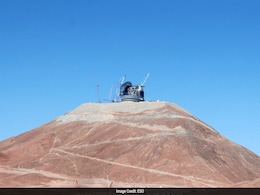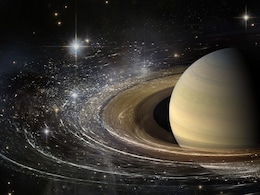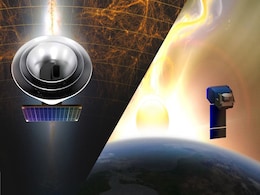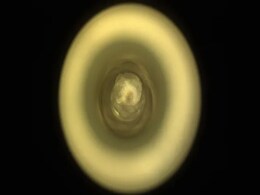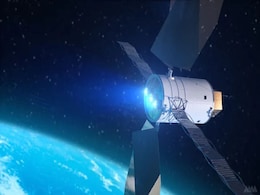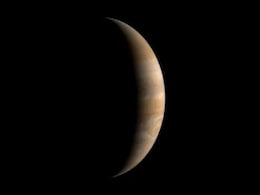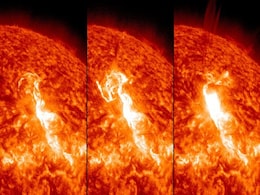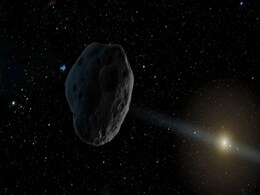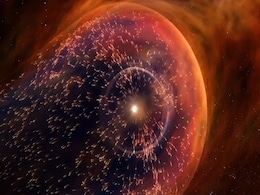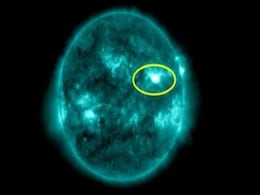New Solar System
- All
- News
- Videos
- Web Stories
-

This New Telescope Can Negate 'False-Positives' Of Alien Life Within Hours
- Friday April 4, 2025
- Science | Edited by Abhinav Singh
The ELT could identify biosignatures on planets in our solar system as well as orbiting Proxima Centauri within hours.
-
 www.ndtv.com
www.ndtv.com
-

Saturn Becomes Undisputed 'Moon King' Of Solar System With Discovery Of 128 New Satellites
- Monday March 17, 2025
- Science | Edited by Abhinav Singh
With the new spottings, Saturn has usurped Jupiter which has 95 known moons, while Uranus (28) and Neptune (16) remain third and fourth on the list.
-
 www.ndtv.com
www.ndtv.com
-

Enceladus' Geysers May Not Come from Underground Ocean, Study Suggests
- Friday March 7, 2025
- Written by Gadgets 360 Staff
Enceladus, one of Saturn’s most intriguing moons, has long been thought to have water plumes erupting from its underground ocean. However, a recent study proposes an alternative explanation, suggesting the plumes may originate from a semi-liquid layer within the moon’s ice shell. Researchers believe shear heating along fractures creates slushy,...
-
 www.gadgets360.com
www.gadgets360.com
-

NASA’s New Missions Will Map the Sun and the Cosmos
- Tuesday March 4, 2025
- Written by Gadgets 360 Staff
NASA is set to launch two major missions, PUNCH and SPHEREx, aboard a SpaceX Falcon 9 from Vandenberg Space Force Base on March 2. PUNCH, a four-satellite system, will study the sun’s corona and space weather, while SPHEREx will create infrared maps of the cosmos to study galaxy evolution and cosmic history. These missions will contribute to a de...
-
 www.gadgets360.com
www.gadgets360.com
-

Over 1 Million Interstellar Objects Could Be Hidden in Our Solar System
- Tuesday February 18, 2025
- Written by Gadgets 360 Staff
A new study reveals that more than 1 million interstellar objects, each larger than the Statue of Liberty, may be residing in the Oort Cloud. These objects, believed to have originated from the Alpha Centauri system, were captured by the Sun’s gravity and are now part of our solar system. Unlike fast-moving interstellar visitors, these objects re...
-
 www.gadgets360.com
www.gadgets360.com
-

NASA Perseverance Rover Discovers Ancient Rock Sample on Mars' Jezero Crater
- Monday February 10, 2025
- Written by Gadgets 360 Staff
NASA’s Perseverance rover has collected a unique rock sample from Mars' Jezero Crater. The rock, named “Silver Mountain,” is believed to be one of the oldest in the solar system, possibly dating back to the Noachian period, over 4 billion years ago. This discovery provides new insights into Mars’ geological history and past environmental co...
-
 www.gadgets360.com
www.gadgets360.com
-

AI Study Finds Organic Molecules on Ceres Likely Came from Asteroid Impacts
- Monday February 3, 2025
- Written by Gadgets 360 Staff
A new AI-driven study has challenged previous assumptions about the origin of organic molecules on Ceres. Scientists have mapped organic-rich areas using data from NASA’s Dawn spacecraft and found no evidence linking these compounds to cryovolcanic activity. Instead, simulations suggest asteroid impacts from the outer belt likely delivered the ma...
-
 www.gadgets360.com
www.gadgets360.com
-

New Supercomputer Set to Propel Electric Spacecraft Technology Forward
- Wednesday January 29, 2025
- Written by Gadgets 360 Staff
Electric propulsion technology, powered by ion engines, is gaining traction for its efficiency in space travel. However, challenges such as back-scattered electrons from the ion plume threaten spacecraft components like solar arrays and antennas. Recent research by scientists from the University of Virginia and the University of Southern California...
-
 www.gadgets360.com
www.gadgets360.com
-

Interstellar Object Could Have Shifted Trajectories of Four Planets, New Research Shows
- Tuesday January 21, 2025
- Written by Gadgets 360 Staff
A recent study suggests that an interstellar object, possibly as massive as eight times Jupiter, may have passed through the solar system billions of years ago, significantly altering the orbits of its outer planets—Jupiter, Saturn, Uranus, and Neptune. Using computer simulations, researchers found that in about 1% of the scenarios, such a close ...
-
 www.gadgets360.com
www.gadgets360.com
-

AI Enhances Northern Lights Classification and Geomagnetic Storm Forecasting
- Friday January 10, 2025
- Written by Gadgets 360 Staff
A breakthrough in auroral research, powered by artificial intelligence, has allowed scientists to classify over 700 million auroral images. This effort, using NASA's THEMIS dataset, will significantly enhance the prediction of geomagnetic storms, which can disrupt Earth's communication and security systems. Led by the University of New Hampshire, t...
-
 www.gadgets360.com
www.gadgets360.com
-

Rubin Observatory’s 2025 Debut Could Unveil Hidden Dark Comets in Space
- Thursday January 9, 2025
- Written by Gadgets 360 Staff
The Vera Rubin Observatory, set to begin operations in 2025, is expected to revolutionise the study of dark comets. These elusive objects, which lack visible tails but exhibit non-gravitational acceleration, have already been identified in our solar system, but their true numbers remain unknown. The observatory's advanced technology, including a po...
-
 www.gadgets360.com
www.gadgets360.com
-

Solar Missions in 2025: Heliophysics Projects and Spacecrafts That Will Study the Sun
- Saturday January 4, 2025
- Written by Gadgets 360 Staff
The study of the sun, its activity, and effects across the solar system will advance in 2025. With Solar Cycle 25 peaking, six NASA missions planned, and new research priorities outlined, scientists are poised to address long-standing questions about solar dynamics and their impacts. Missions such as IMAP, ESCAPADE, and PUNCH will investigate solar...
-
 www.gadgets360.com
www.gadgets360.com
-

Massive Solar Flare Closes 2024 With Radio Blackouts and Auroral Possibilities
- Tuesday December 31, 2024
- Written by Gadgets 360 Staff
An X1.1-class solar flare on December 29, 2024, caused strong radio blackouts on Earth, marking another significant event in the increasingly active Solar Cycle 25. Detected by NOAA's GOES-16 satellite, the eruption raises questions about a potential coronal mass ejection, which could amplify auroras during New Year celebrations. While impactful, t...
-
 www.gadgets360.com
www.gadgets360.com
-

James Webb Telescope Spots 138 New Asteroids in the Main Belt, Some Heading Towards Earth
- Tuesday December 17, 2024
- Written by Gadgets 360 Staff
Astronomers have discovered 138 new asteroids in the main asteroid belt between Mars and Jupiter using the James Webb Space Telescope (JWST). These decametre-sized asteroids, some of which are on paths that could bring them close to Earth, were identified through a new computational technique. The discovery enhances our understanding of small space...
-
 www.gadgets360.com
www.gadgets360.com
-

Here's How Our Solar System Could Capture Interstellar Objects And Rogue Planets
- Thursday December 5, 2024
- Science | Edited by Ritu Singh
The key to this phenomenon lies in the concept of phase space, a mathematical representation that describes the state of a dynamical system like our solar system.
-
 www.ndtv.com
www.ndtv.com
-

This New Telescope Can Negate 'False-Positives' Of Alien Life Within Hours
- Friday April 4, 2025
- Science | Edited by Abhinav Singh
The ELT could identify biosignatures on planets in our solar system as well as orbiting Proxima Centauri within hours.
-
 www.ndtv.com
www.ndtv.com
-

Saturn Becomes Undisputed 'Moon King' Of Solar System With Discovery Of 128 New Satellites
- Monday March 17, 2025
- Science | Edited by Abhinav Singh
With the new spottings, Saturn has usurped Jupiter which has 95 known moons, while Uranus (28) and Neptune (16) remain third and fourth on the list.
-
 www.ndtv.com
www.ndtv.com
-

Enceladus' Geysers May Not Come from Underground Ocean, Study Suggests
- Friday March 7, 2025
- Written by Gadgets 360 Staff
Enceladus, one of Saturn’s most intriguing moons, has long been thought to have water plumes erupting from its underground ocean. However, a recent study proposes an alternative explanation, suggesting the plumes may originate from a semi-liquid layer within the moon’s ice shell. Researchers believe shear heating along fractures creates slushy,...
-
 www.gadgets360.com
www.gadgets360.com
-

NASA’s New Missions Will Map the Sun and the Cosmos
- Tuesday March 4, 2025
- Written by Gadgets 360 Staff
NASA is set to launch two major missions, PUNCH and SPHEREx, aboard a SpaceX Falcon 9 from Vandenberg Space Force Base on March 2. PUNCH, a four-satellite system, will study the sun’s corona and space weather, while SPHEREx will create infrared maps of the cosmos to study galaxy evolution and cosmic history. These missions will contribute to a de...
-
 www.gadgets360.com
www.gadgets360.com
-

Over 1 Million Interstellar Objects Could Be Hidden in Our Solar System
- Tuesday February 18, 2025
- Written by Gadgets 360 Staff
A new study reveals that more than 1 million interstellar objects, each larger than the Statue of Liberty, may be residing in the Oort Cloud. These objects, believed to have originated from the Alpha Centauri system, were captured by the Sun’s gravity and are now part of our solar system. Unlike fast-moving interstellar visitors, these objects re...
-
 www.gadgets360.com
www.gadgets360.com
-

NASA Perseverance Rover Discovers Ancient Rock Sample on Mars' Jezero Crater
- Monday February 10, 2025
- Written by Gadgets 360 Staff
NASA’s Perseverance rover has collected a unique rock sample from Mars' Jezero Crater. The rock, named “Silver Mountain,” is believed to be one of the oldest in the solar system, possibly dating back to the Noachian period, over 4 billion years ago. This discovery provides new insights into Mars’ geological history and past environmental co...
-
 www.gadgets360.com
www.gadgets360.com
-

AI Study Finds Organic Molecules on Ceres Likely Came from Asteroid Impacts
- Monday February 3, 2025
- Written by Gadgets 360 Staff
A new AI-driven study has challenged previous assumptions about the origin of organic molecules on Ceres. Scientists have mapped organic-rich areas using data from NASA’s Dawn spacecraft and found no evidence linking these compounds to cryovolcanic activity. Instead, simulations suggest asteroid impacts from the outer belt likely delivered the ma...
-
 www.gadgets360.com
www.gadgets360.com
-

New Supercomputer Set to Propel Electric Spacecraft Technology Forward
- Wednesday January 29, 2025
- Written by Gadgets 360 Staff
Electric propulsion technology, powered by ion engines, is gaining traction for its efficiency in space travel. However, challenges such as back-scattered electrons from the ion plume threaten spacecraft components like solar arrays and antennas. Recent research by scientists from the University of Virginia and the University of Southern California...
-
 www.gadgets360.com
www.gadgets360.com
-

Interstellar Object Could Have Shifted Trajectories of Four Planets, New Research Shows
- Tuesday January 21, 2025
- Written by Gadgets 360 Staff
A recent study suggests that an interstellar object, possibly as massive as eight times Jupiter, may have passed through the solar system billions of years ago, significantly altering the orbits of its outer planets—Jupiter, Saturn, Uranus, and Neptune. Using computer simulations, researchers found that in about 1% of the scenarios, such a close ...
-
 www.gadgets360.com
www.gadgets360.com
-

AI Enhances Northern Lights Classification and Geomagnetic Storm Forecasting
- Friday January 10, 2025
- Written by Gadgets 360 Staff
A breakthrough in auroral research, powered by artificial intelligence, has allowed scientists to classify over 700 million auroral images. This effort, using NASA's THEMIS dataset, will significantly enhance the prediction of geomagnetic storms, which can disrupt Earth's communication and security systems. Led by the University of New Hampshire, t...
-
 www.gadgets360.com
www.gadgets360.com
-

Rubin Observatory’s 2025 Debut Could Unveil Hidden Dark Comets in Space
- Thursday January 9, 2025
- Written by Gadgets 360 Staff
The Vera Rubin Observatory, set to begin operations in 2025, is expected to revolutionise the study of dark comets. These elusive objects, which lack visible tails but exhibit non-gravitational acceleration, have already been identified in our solar system, but their true numbers remain unknown. The observatory's advanced technology, including a po...
-
 www.gadgets360.com
www.gadgets360.com
-

Solar Missions in 2025: Heliophysics Projects and Spacecrafts That Will Study the Sun
- Saturday January 4, 2025
- Written by Gadgets 360 Staff
The study of the sun, its activity, and effects across the solar system will advance in 2025. With Solar Cycle 25 peaking, six NASA missions planned, and new research priorities outlined, scientists are poised to address long-standing questions about solar dynamics and their impacts. Missions such as IMAP, ESCAPADE, and PUNCH will investigate solar...
-
 www.gadgets360.com
www.gadgets360.com
-

Massive Solar Flare Closes 2024 With Radio Blackouts and Auroral Possibilities
- Tuesday December 31, 2024
- Written by Gadgets 360 Staff
An X1.1-class solar flare on December 29, 2024, caused strong radio blackouts on Earth, marking another significant event in the increasingly active Solar Cycle 25. Detected by NOAA's GOES-16 satellite, the eruption raises questions about a potential coronal mass ejection, which could amplify auroras during New Year celebrations. While impactful, t...
-
 www.gadgets360.com
www.gadgets360.com
-

James Webb Telescope Spots 138 New Asteroids in the Main Belt, Some Heading Towards Earth
- Tuesday December 17, 2024
- Written by Gadgets 360 Staff
Astronomers have discovered 138 new asteroids in the main asteroid belt between Mars and Jupiter using the James Webb Space Telescope (JWST). These decametre-sized asteroids, some of which are on paths that could bring them close to Earth, were identified through a new computational technique. The discovery enhances our understanding of small space...
-
 www.gadgets360.com
www.gadgets360.com
-

Here's How Our Solar System Could Capture Interstellar Objects And Rogue Planets
- Thursday December 5, 2024
- Science | Edited by Ritu Singh
The key to this phenomenon lies in the concept of phase space, a mathematical representation that describes the state of a dynamical system like our solar system.
-
 www.ndtv.com
www.ndtv.com

